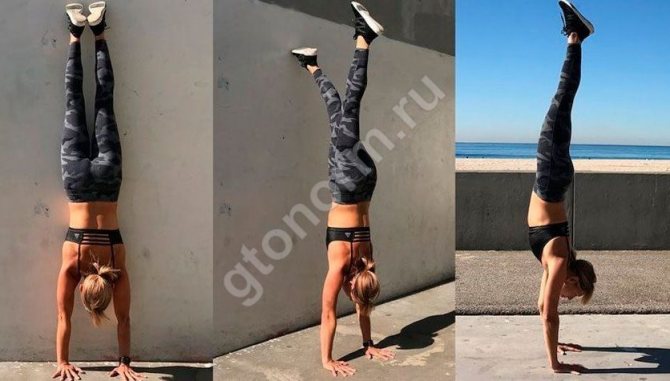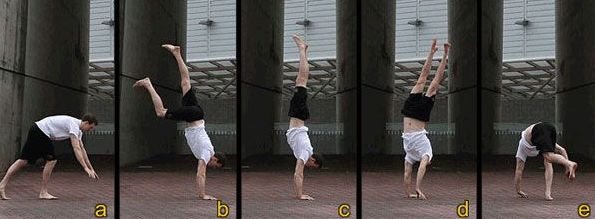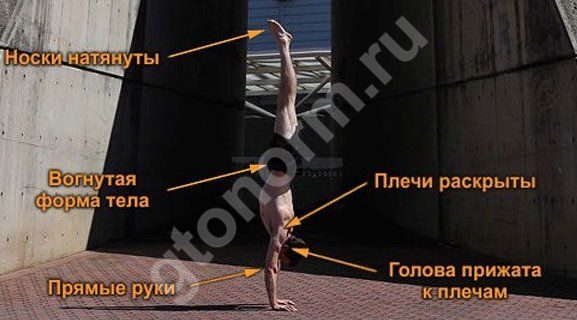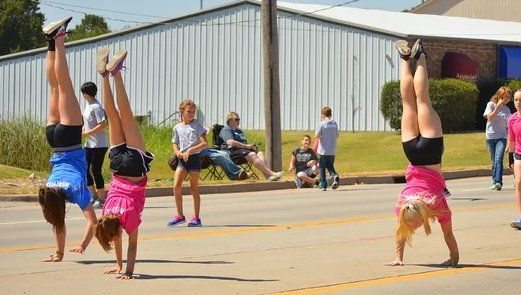Do you want to know how to learn to walk on your hands on your own or with the help of a partner? Do you think this exercise is only available to trained gymnasts? No matter how it is - in fact, with proper training and good physical condition of individual muscle groups, anyone can learn to walk like this.
In the article we will look at how to walk on your hands, using the help of a support or a belaying partner, as well as how to stand and move independently. We will also tell you about the most popular mistakes that almost all beginners make, and how to avoid them. In conclusion, we will briefly explain why such walking is useful and whether you can harm yourself.
Preparatory stage
First of all, you must objectively assess the level of your physical fitness and if it turns out to be not strong enough, you will have to pump yourself up. Let's look at the benefits of walking on your hands and what muscle groups it effectively trains:
- Shoulders. Test yourself, how many times can you pull yourself up on the bar and do push-ups while lying on the floor? If you do it 5-10 times and without effort, your shoulders are strong enough to start walking upside down.
The best way to clearly demonstrate how to learn to walk on your hands is a video, just open any video hosting site, enter the desired search query and follow the instructions.
- To learn to walk upside down, you need to have flexible wrists. Stretch your upper limbs forward with your palms facing down and your fingertips pointing upward. If you can position your hands perpendicular to your arms, then your wrists are flexible enough.
- If you are interested in how to quickly learn to walk on your hands and not fall, first develop your sense of balance. Perform a simple exercise: stand up straight and tilt your torso forward, stretch your right arm forward and your left leg back and fix the position. Your torso, arm and leg should be in one line, strictly parallel to the floor. If you can stand like this for at least 30 seconds, you have a good sense of balance.

In order to properly prepare the body for future stress, we recommend performing the following exercises every day:
- Pull-ups on the bar;
- Lying push-ups;
- Walking on 4 supports. Place your palms on the floor - make sure that they, like your feet, are in full contact with the surface. Start moving around the room, while trying to keep your back straight, do not hunch or bend;
- Sit on the floor, place your palms behind your back and slightly spread your elbows. Bend your legs at the knees and place them on the floor, also slightly apart. Lift your heel up, the weight of the body should transfer to the limbs. Now start moving in this position.
The main thing is to believe in yourself
I learned how to stand on my hands in a week, doing it 5-10 minutes a day. At the same time, about six months ago I also tried to study, but my attempts were in vain. Looking back, I see two big mistakes:
- I learned to stand against a wall, resting my feet on it. In this position, you will not understand how hard you need to push off the floor to find balance. Therefore, I kept leaning on my feet, dangling back and forth and could not find a stable point.
- I thought it was very difficult and would take a long time to train. But recently I learned how to snowboard and balance on a special board. After that, I realized that my balance was fine. After some training, I was able to balance myself in a handstand.
Therefore, I concluded that the most important thing is to believe that you can do it.
If you have questions, ask them in the comments.
How to learn to walk upside down with the help of a partner?
Walking on hands with the help of a partner is considered a lighter version of this exercise, because in this case a person does not need to worry about balance. Also, he has no fear of falling, because he is confident that his partner will definitely back him up and keep his ankles in the right position. By the way, the partner method is an excellent option that helps to learn how to walk on your hands correctly, for children and adults without experience.

The essence of the technique is as follows: as soon as a person pushes his legs upward, his partner insures him, preventing the risk of falling. While walking, he carefully holds his ankles, preventing his legs from falling straight, backward or to the sides. The main disadvantage of such walking is that the athlete will not be able to learn to maintain balance on his own, which means he will not be able to walk like this without support.
Thus, if you want to quickly teach your child to walk on his hands, start practicing right away without additional support.
Common mistakes parents make
Many young mothers, trying to teach their child to walk, look for new methods that often do not help, but, on the contrary, delay the process and harm the baby. There are several erroneous actions that parents most often make:
- Walkers and jumpers. These devices should be kept away from children who are starting to walk independently. It is best to replace them with children's cars that can be moved and pushed.
- You should not force your baby to stand, holding onto a support for a long time; he should learn to squat. The fact is that in a straight position the ligaments are sprained, and this can deform the foot.
- You cannot try to teach a child to walk if he has not reached a certain age. Firstly, this will not give the desired result, and secondly, it can cause the development of flat feet and disorders in the spine. As soon as the baby’s bones and muscles become stronger, he will show a desire to stand up.
- Uncomfortable shoes. This choice must be taken seriously, purchase only high-quality models, preferably with orthopedic insoles, they help the development of the child’s musculoskeletal system.
- Overprotection does not promote independence, and the mother’s constant shouts of “be careful, don’t fall” only disturb the child. It is necessary to give the baby freedom, he should take his first steps without fear, and the mother should just be there and support or insure him if something happens.
And finally, watch the video from the pediatrician, which explains in detail what is fraught with forcing children to get back on their feet:
As you can see, teaching a baby to walk is not difficult, but it is important to understand whether his body is ready for this. Remember - the important thing here is to do no harm.
How to learn to walk upside down on your own?
First of all, you must understand that it is impossible to learn how to walk on your hands correctly in 5 minutes from scratch; at a minimum, you will need time to assess the level of your training. If you are sure that you have strong enough shoulders, flexible wrists and a good sense of balance, feel free to try it.
- Any workout always begins with a warm-up. Be sure to do a few exercises to warm up your shoulder muscles, abs, back, and wrists.
Do you know what muscles work when walking on your hands? Triceps, shoulders, abs and lower back, these are the ones that need to be warmed up first.
- We do not recommend starting to learn to walk upside down against a wall, as this will cause you to push off the floor harder, knowing that there is support ahead of you. If you start learning to stand in the middle of the room, you will learn to balance much faster, which means you will be able to walk in a shorter time.
- Make sure that in the place where you are trying to learn to walk on your hands, there are no foreign objects that could hurt you if you fall.
- By the way, about the fall. Don’t be afraid of him, the most important thing is to learn to group correctly. We will talk about this below, in the section about the correct exit from the rack.
- If you are afraid to immediately stand on your outstretched limbs, try doing a forearm stand. Place them on the floor, push up with your feet and fix your shoulders perpendicular to the floor. Stay like this for about 30 seconds. Thanks to the increased area of the fulcrum, such a stance allows you to “make friends” with balance much faster.
- Any training in the “walking on your hands” exercise always begins with the main rule: your shoulders should be kept strictly above your palms. Place the latter on the floor and slightly move your shoulders forward so that they are strictly above your palms, in one line. Now gently push your feet up. Don't be afraid, otherwise the push will be weak and you will fall over.
- Once you manage to secure your stance, begin moving your arms as you take steps. Keep your legs perpendicular to the floor, do not lean forward, backward or to the sides or spread them apart.
Don't be discouraged if everything doesn't work out right away. The most important thing is persistence and a lot of training. And after you have mastered the technique perfectly, you can try handstand push-ups.

Problems walking
If a child falls very often when walking, constantly wants to walk only holding your hand, then one of the possible reasons may be poor vision, we recommend consulting an ophthalmologist.
Read on for more tips on your child’s development.
Sometimes when a child walks, he steps not on his entire foot, but on his tiptoes. Many parents don’t understand why their baby walks on his toes, so read the article - reasons and what to do?
Updated: Another popular problem is when a child is afraid to walk on his own, so read why he is afraid and what should be done in this case - link to article
Video No. 2: The child refuses to walk on his own
Video answer to the question:
"Hello! The daughter started walking at 11 months, took a few steps on her own without support, then fell slightly and flatly refuses to walk on her own, only by hand, and can barely hold onto a finger, or lean on furniture, etc. At one year old, we had an examination, everything was fine, we had a neurologist or an orthopedist look at our feet, we had slightly valgus feet, we had a massage course - no changes, we were running around holding hands. Should I contact a neurologist or psychologist, or should I not touch the child, how will it go? Perhaps there are some special psychological techniques or games to overcome this fear? Thanks in advance for your answer.”
Summary conclusion:
- Don't rush your child.
- Develop an interest in walking.
- Find a role model.
- Hold it correctly.
- Avoiding walkers.
- Walking without shoes.
Important! Read also: Children grow very quickly. In just a few months, your child will stop lying in the crib, begin to crawl, then walk, explore new territories, first in his room, and then throughout the house, so it is very important to secure the house for the child. How to do this correctly, read in this article - how to secure a home for a small child
Learning to walk: video No. 3:
Very useful video. We highly recommend viewing!
Interview with a physical therapy doctor (video No. 4)
First baby steps. What time should a child start walking? Varvara Vladimirovna answers:
Patience, wisdom and happiness to you!
Read on: what a year old child can do (basic skills)
How to learn how to get out of a stance correctly?
We'll look at what walking on your hands does a little later, but now let's figure out what to do if you start to fall:
- Do not panic;
- Try to group and jump to the side - this way the risk of hitting hard is minimal;
- Bend your knees and arch your back, take a few quick steps forward - as a result, you will fall on your feet without hitting your back;
- If you have a perfect sense of balance, we will teach you not to fall at all. If you feel like you're falling over, bend your legs and move them forward slightly. The center of gravity will force you to take several steps forward. During this time you should be able to fix the balance. If it doesn’t work, read point 3.
- Remember, learning to fall correctly is no less important than, strictly speaking, walking!

The main mistakes of beginners
- Many people neglect to warm up, resulting in sprains and severe muscle pain the next morning;
- It is best to immediately go to the center of the hall, without relying on a partner or the wall;
- Because of the fear of hitting your back, it can be very difficult to push off with your feet for the first time. We recommend placing pillows and mats around - then it will not be so dangerous;
- It is wrong to take a stance if your palms are on the floor much further than your shoulders. You will almost certainly fall when your body tries to rise vertically in a forward motion.
- If you are afraid to make a confident push up, practice walking on your hands and feet at the same time, and also learn how to properly come out of your stance. In other words, learn to fall and not be afraid of being hit.

What does such walking give?
This exercise perfectly develops the muscles of the shoulder girdle, back and abs. It is not difficult to do, but it greatly improves self-esteem. Try to explain to your child how to learn to walk on your hands at home, and within a week he will conquer his classmates with this funny and, at the same time, spectacular trick.
This exercise improves physical qualities such as balance, endurance, and strength. It perfectly strengthens the core, makes the shoulders and forearms stronger. It also stimulates the functioning of the endocrine system, since in the “upside down” position, blood flows more strongly to the head, thereby triggering the production and absorption of hormones important for normal functioning. It’s also fun, which means that if you learn to walk upside down, you’ll always be able to get yourself back into a great mood.

This exercise has contraindications, performing a stance in which can cause harm to the body:
- Due to the flow of blood to the head, pressure may rise, so people prone to pressure changes are not recommended to walk like this.
- Also, this position of the body increases pressure on the eyes, so if you have glaucoma, hanging upside down is prohibited.
- If you have thin skin, a headstand can cause broken capillaries on your face, which is not aesthetically pleasing.
To summarize all of the above, anyone can learn to walk on their hands. The most important thing is to be persistent, have a strong desire and strong hands. Throw your fears aside - you will definitely conquer this mountain!











